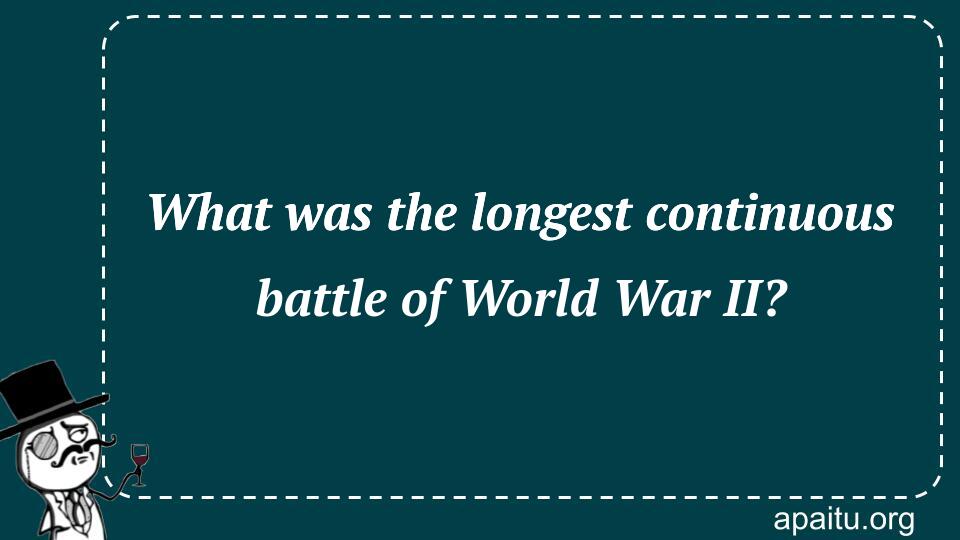Question
Here is the question : WHAT WAS THE LONGEST CONTINUOUS BATTLE OF WORLD WAR II?
Option
Here is the option for the question :
- Battle of Iwo Jima
- Battle of the Bulge
- Battle of the Atlantic
- Battle of Stalingrad
The Answer:
And, the answer for the the question is :
Explanation:
The Battle of the Atlantic began on the same day that World War II formally began in 1939 and lasted until Germany surrendered in 1945. It is the name given to the ongoing struggle for control of the Atlantic Ocean during the war, with Canada frequently playing a critical role in assisting the Allied nations.

Welcome to the enthralling world of World War II, where battles and conflicts shaped the course of history. Today, we delve into the longest continuous battle of this global conflict—the Battle of the Atlantic. Join us as we uncover the significance, challenges, and pivotal moments of this maritime struggle that lasted throughout the war and played a crucial role in the ultimate outcome.
The Battle of the Atlantic, which spanned the entire duration of World War II, was a relentless confrontation between Allied forces and the German Kriegsmarine, primarily focused on controlling the vital shipping routes of the Atlantic Ocean. The battle began in September 1939 with the outbreak of war and continued until May 1945, lasting a staggering six years and eight months.
At the heart of the Battle of the Atlantic was the struggle for control over the supply lines that sustained the war efforts of both the Allies and the Axis powers. The German U-boats, or submarines, posed a significant threat to Allied convoys, targeting merchant ships carrying vital supplies, troops, and equipment across the Atlantic. By disrupting these supply lines, the Germans aimed to weaken the Allied war effort and tilt the balance of power in their favor.
The Battle of the Atlantic was characterized by a deadly game of cat and mouse between the German U-boats and the Allied naval forces. The U-boats employed various tactics, such as wolf pack attacks, where groups of submarines would coordinate their efforts to overwhelm and sink Allied convoys. The Allies, on the other hand, deployed escort ships, aircraft, and advanced technologies to counter the U-boat threat.
One of the key turning points in the Battle of the Atlantic was the development and implementation of convoy systems by the Allies. By organizing merchant ships into convoys and providing them with naval escorts, the Allies were able to enhance their defenses and improve the chances of safely reaching their destinations. This strategic shift proved instrumental in reducing the losses inflicted by the U-boats and ensuring the uninterrupted flow of supplies to the Allied forces.
The Battle of the Atlantic was not limited to the actions at sea. It also involved aerial combat, as both sides utilized aircraft for reconnaissance, anti-submarine warfare, and attacks on enemy vessels. Additionally, advancements in technology played a crucial role in the battle. The Allies developed radar, sonar, and cryptographic systems that provided them with an advantage in detecting and countering the U-boats’ movements.
The battle was grueling and relentless, with both sides suffering heavy losses. The German U-boats, despite their initial successes, faced increasing challenges as the war progressed. The Allies’ technological advancements, improved strategies, and increased naval strength gradually turned the tide in their favor. The U-boat losses escalated, and the Allied forces gained the upper hand in the Battle of the Atlantic.
The Battle of the Atlantic reached its climax in 1943 when the Allies achieved a significant victory. The implementation of new tactics, the introduction of advanced anti-submarine warfare technologies, and the increased cooperation between Allied forces all contributed to a turning point in the battle. From that point onward, the U-boat threat diminished, and the Allies gained greater control over the Atlantic shipping routes.
The Battle of the Atlantic had far-reaching consequences for the outcome of World War II. The ability of the Allies to maintain their supply lines and transport troops and equipment across the Atlantic was crucial in their eventual victory. Without the successful outcome of this protracted battle, the Allied forces would have faced significant challenges in sustaining their war effort and turning the tide against the Axis powers.
the Battle of the Atlantic stands as the longest continuous battle of World War II. Lasting over six years, it was a fierce struggle for control of the Atlantic shipping routes and the vital supplies they carried. The battle showcased the determination, resilience, and technological advancements of both the Allied and Axis forces. Ultimately, the Allied victory in the Battle of the Atlantic played a pivotal role in securing their ultimate triumph in World War II.